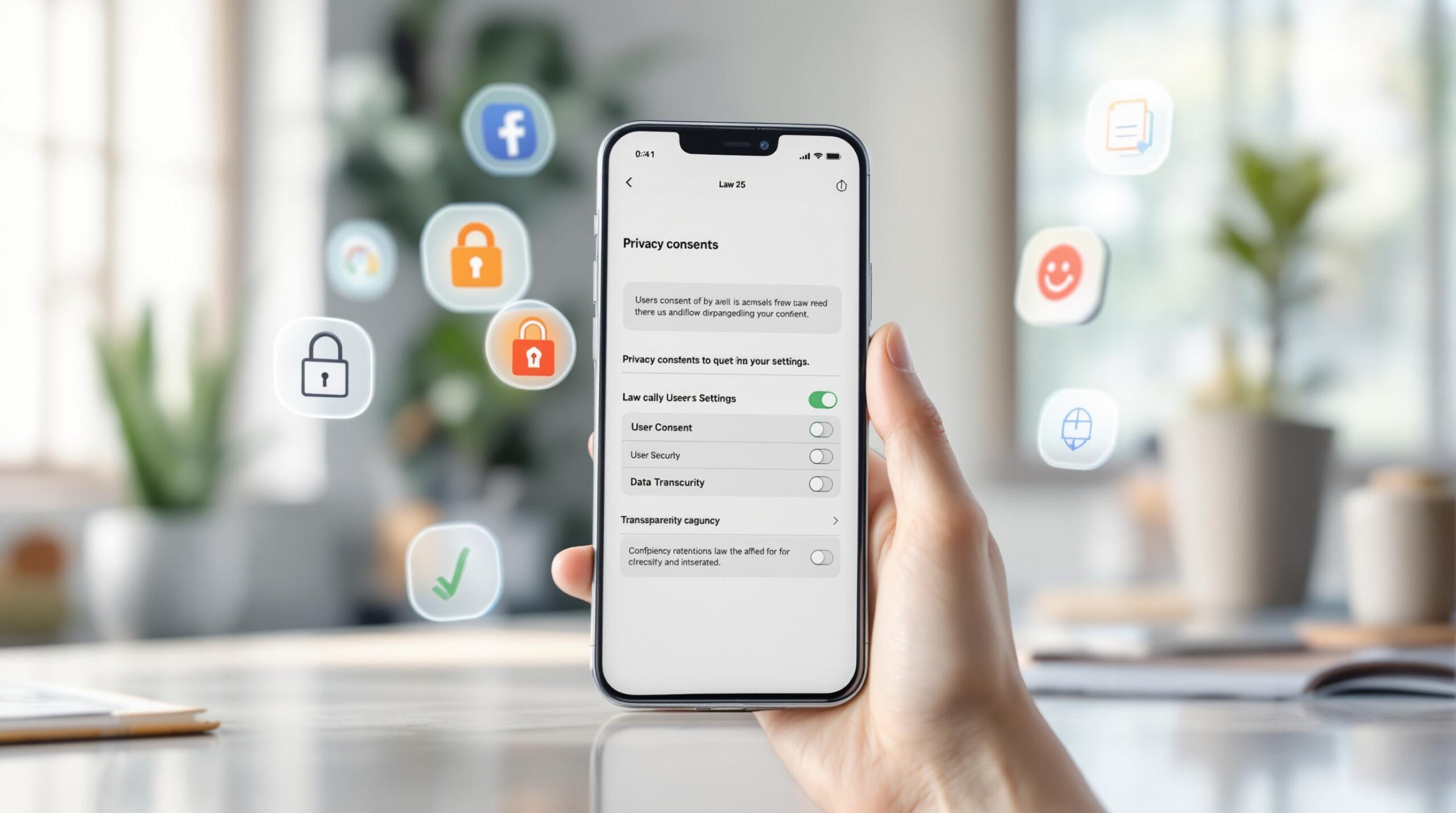
Québec’s Law 25 introduces strict privacy rules for mobile apps handling personal data of Québec residents, no matter where your business operates. Non-compliance can lead to fines up to CA$25 million or 4% of global revenue.
Here’s what you need to know:
- Explicit Consent: Apps must get clear, informed user permission for data collection and use.
- Privacy by Design: Build apps with strong privacy settings enabled by default.
- Transparency: Clearly explain what data is collected, why, for how long, and if shared with third parties.
- Data Portability: By September 2024, users must be able to access and transfer their data.
- Security: Use encryption, access controls, and regular audits to safeguard data.
Key Deadlines:
- Phase 1 (Sept 2022): Initial privacy rules and breach reporting.
- Phase 2 (Sept 2023): Consent mechanisms and transparency requirements.
- Phase 3 (Sept 2024): Data portability and advanced user rights.
To comply, review your app’s data practices, update privacy policies, and implement robust security measures. Law 25 isn’t just a legal obligation – it’s a way to build trust with your users.
Quebec’s Law 25 Explained: Quick Data Privacy Guide for …

Building Privacy-First Mobile Apps
Creating mobile apps with a focus on privacy means incorporating strong protections right from the start, as outlined by Law 25.
Privacy-Focused App Design
A "Privacy by Default" approach ensures that apps automatically set the highest privacy protections for users.
| Design Element | Privacy-Focused Approach |
|---|---|
| Default Settings | Automatically enable the highest privacy settings |
| Data Collection | Limit collection to only what’s absolutely necessary |
| User Controls | Provide easy-to-access privacy settings |
Once these default protections are in place, the next step is to establish clear and transparent consent processes.
Getting User Permission
Law 25 requires user consent to be explicit, well-informed, and specific to each purpose. To comply, mobile apps should:
- Present consent requests individually, not bundled together
- Clearly state the purpose for each data use
- Provide detailed opt-in and opt-out choices
- Make it easy for users to withdraw consent at any time
These practices ensure users are fully informed and in control of their data.
Clear Data Collection Notices
Transparency is a key requirement under Law 25, which means apps must include clear and accessible data collection notices. To achieve this:
- Write in plain, easy-to-understand language to explain how data will be used
- Clearly list the specific data being collected
- State how long the data will be stored
- Identify any third parties that may access the data
- Include details about any data transfers outside Quebec
These steps not only meet legal requirements but also build trust with users.
Data Security Best Practices
Strong security practices are the backbone of privacy compliance, supporting every privacy-focused decision. Effective data security measures are crucial for meeting Law 25 requirements, protecting user information, and maintaining trust.
Data Protection Methods
Encryption is a key element of data security under Law 25. The Advanced Encryption Standard (AES) is highly effective for protecting sensitive user data. Key measures include:
| Security Layer | Implementation Details |
|---|---|
| Data Encryption | Use AES encryption for data at rest and in transit |
| Network Security | Employ firewalls and intrusion detection systems |
| Access Protection | Utilize hardware security modules (HSMs) for key management |
| Monitoring | Implement real-time threat detection and response |
Since human error accounts for 95% of breaches, security efforts should combine technical solutions with comprehensive staff training. Beyond encryption and network protections, enforce strict data storage policies to further safeguard user information.
Data Storage Time Limits
Law 25 requires organizations to limit how long personal data is stored. When data is no longer needed, it must either be destroyed or anonymized for legitimate purposes. To manage this effectively, organizations should:
- Set specific retention periods for each data category.
- Automate deletion schedules to ensure timely removal.
- Keep detailed records of data destruction activities.
- Conduct regular audits of stored data to ensure compliance.
Pair these lifecycle management practices with strict access controls to minimize the risk of unauthorized exposure.
Access Control Systems
Role-based access control (RBAC) ensures that only authorized individuals can access sensitive information. A well-designed RBAC system includes:
1. Defining Access Levels
Assign permissions based on job responsibilities, ensuring employees only access the data they need.
2. Monitoring Data Access
Use logging systems to track who accesses data, when, and for what purpose. This creates an audit trail for compliance and security monitoring.
3. Conducting Regular Access Reviews
Periodically review access permissions to confirm they remain relevant and necessary.
"Compliance with Bill 25 is not just a matter of law abidance but also a matter of trust and respect toward your customers and partners. Protecting their personal data demonstrates your commitment to their security and privacy." – Genatec
Stay proactive by regularly updating your security measures. Perform tests like penetration testing and vulnerability scans to identify and address potential weaknesses.
sbb-itb-7af2948
User Data Rights and Controls
Law 25 highlights the importance of giving users control over their personal data. Mobile apps must provide clear and easy-to-use tools for managing this information. These features not only ensure compliance but also help establish trust.
Data Download Options
Users should have access to their personal data in formats that are easy to understand and use. Common download formats include:
| Data Format | Advantages | Tips for Implementation |
|---|---|---|
| CSV | Simple to use with spreadsheets | Add clear column headers and descriptive labels |
| JSON | Structured and machine-readable | Organize related data into logical groups |
| XML | Compatible with many systems | Use clear and consistent element names |
Make sure export options are well-labeled and easy to find. Once users can access their data, the next step is to provide strong privacy settings.
Privacy Settings Controls
Privacy settings should be:
- Easy to find, ideally accessible from the main menu
- Pre-set with strong privacy safeguards
- Transparent about how data is used
- Flexible, allowing users to adjust permissions at a detailed level
Data Update and Removal
After addressing data access and privacy settings, apps must also make it simple for users to update or remove their data. Key features include:
-
Data Correction Tools
Allow users to view their stored details, request corrections, and monitor the status of their submissions. -
Deletion Options
Provide straightforward processes for full account deletion, selective data removal, or anonymization. -
Verification System
Use secure identity checks before handling sensitive requests. Maintain records of changes for accountability.
Anonymous data is not subject to portability rules. Additionally, requests that create significant practical challenges may be declined, provided exceptions are clearly documented and communicated.
Law 25 Compliance Steps
Required Actions
Here’s how to meet the requirements of Law 25:
-
Conduct a Privacy Audit
Review your app’s data practices to identify where data is collected, how it’s stored, and how it flows through your systems. This will help uncover any compliance gaps. -
Update Your Privacy Policy
Make sure your privacy policy is clear and transparent. It should include details about:- Why you collect data
- How long you keep it
- The rights users have and the controls they can use
- Security measures in place
- Contact information for privacy-related questions
-
Implement Security Measures
Put strong security measures in place and test them regularly. These should include:- Data encryption during transmission
- Secure authentication processes
- Regular security testing
- Detailed access logs and monitoring systems
Once these steps are handled, consider how software tools can make compliance easier.
Compliance Software Options
Using specialized software can help automate and simplify many compliance tasks.
| Feature | Implementation | Benefit |
|---|---|---|
| Consent Management | Cookie banners, preference centers | Tracks consent automatically |
| DSAR Handling | User request portals | Simplifies data access requests |
| Policy Updates | Auto-updating legal documents | Keeps compliance records current |
Regular Compliance Checks
Compliance isn’t a one-time task – it requires ongoing effort. Regularly review and update the following:
- Consent records, data retention policies, and access controls
- Security protocols, encryption techniques, and vulnerability checks
- Privacy policies, team training, and third-party vendor compliance
Staying proactive helps ensure you remain compliant with Law 25 requirements.
Conclusion: Meeting Law 25 Standards
Law 25 introduces stricter privacy rules, raising the bar for mobile app development and data protection. It applies not just within Quebec but to any app handling personal data from Quebec residents.
Penalties are steep, ranging from $5,000 to $25 million CAD, with a minimum claim of $1,000 CAD. Following these regulations not only helps avoid fines but also strengthens user trust.
Key requirements include explicit consent, default privacy settings, and robust data protection measures. These rules aim to improve how data is managed and safeguarded for everyone involved.
Staying compliant means staying proactive. The final phase, effective September 2024, introduces data portability rights, emphasizing the need to adapt to evolving privacy standards. For mobile app developers, this involves:
- Regularly reviewing and updating privacy policies
- Assigning privacy officers to actively manage data protection
- Performing detailed Privacy Impact Assessments for data transfers
- Updating security measures to address new threats
Since Law 25 applies globally to any organization handling data from Quebec residents, it presents mobile app developers with a chance to create privacy-focused apps that enhance user confidence.

